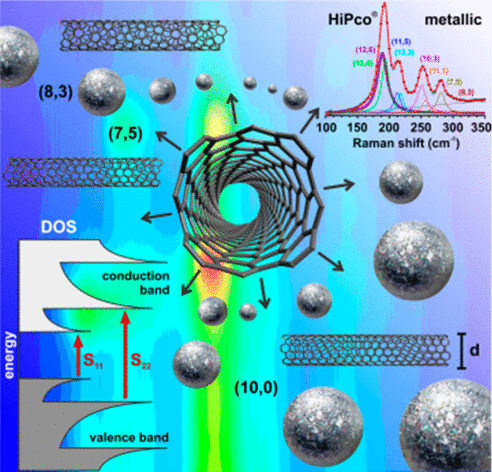当前位置:
X-MOL 学术
›
J. Am. Chem. Soc.
›
论文详情
Our official English website, www.x-mol.net, welcomes your
feedback! (Note: you will need to create a separate account there.)
Understanding the Electron-Doping Mechanism in Potassium-Intercalated Single-Walled Carbon Nanotubes
Journal of the American Chemical Society ( IF 14.4 ) Pub Date : 2020-01-07 , DOI: 10.1021/jacs.9b11370 Claudia Kröckel 1 , María Rosa Preciado-Rivas 2 , Victor Alexander Torres-Sánchez 2 , Duncan J Mowbray 2 , Stephanie Reich 3 , Frank Hauke 1 , Julio C Chacón-Torres 2 , Andreas Hirsch 1
Journal of the American Chemical Society ( IF 14.4 ) Pub Date : 2020-01-07 , DOI: 10.1021/jacs.9b11370 Claudia Kröckel 1 , María Rosa Preciado-Rivas 2 , Victor Alexander Torres-Sánchez 2 , Duncan J Mowbray 2 , Stephanie Reich 3 , Frank Hauke 1 , Julio C Chacón-Torres 2 , Andreas Hirsch 1
Affiliation

|
Single-walled carbon nanotubes (SWCNTs) can be doped with potassium, similar to graphite, leading to intercalation compounds. These binary systems exhibit a clear metallic character. However, the entire picture of how electron doping (e-doping) modifies the SWCNTs' vibrational spectra as a function of their diameter, chirality, and metallicity is still elusive. Herein, we present a detailed study of the intercalation and solid state reduction of metallic and semiconducting enriched HiPco® SWCNTs. We performed a combined experimental and theoretical study of the evolution of their Raman response with potassium exposure, focusing specifically on their radial breathing mode (RBM). We found the charge donated from the potassium atoms occupies anti-bonding π orbitals of the SWCNTs, weakening their C-C bonds, and reducing the RBM frequency. This RBM downshift with increasing doping level is quasi-linear with a step-like behavior when the Fermi level crosses a van Hove singularity for semiconducting species. Moreover, this weakening of the C-C bonds is greater with decreasing curvature, or increasing diameter. Overall, this suggests the RBM downshift with e-doping is proportional to both the SWCNT's integrated density of states (DOS) ϱ(ε) and diameter d. We have provided a precise and complete description of the complex electron doping mechanism in SWCNTs up to a charge density of -18 me/C, far beyond that achievable by standard gate voltage studies, not being the highest doping possible, but high enough to track the effects of doping in SWCNTs based on their excitation energy, diameter, band gap energy, chiral angle, and metallicity. This work is highly relevant to tuning the electronic properties of SWCNTs for applications in nanoelectronics, plasmonics, and thermoelectricity.
中文翻译:

了解插钾单壁碳纳米管的电子掺杂机制
单壁碳纳米管 (SWCNT) 可以掺杂钾,类似于石墨,导致嵌入化合物。这些二元系统表现出明显的金属特征。然而,关于电子掺杂(e 掺杂)如何改变 SWCNT 的振动光谱作为其直径、手性和金属丰度的函数的整个图景仍然难以捉摸。在此,我们详细研究了富含金属和半导体的 HiPco® SWCNT 的嵌入和固态还原。我们对钾暴露时他们的拉曼响应的演变进行了一项结合实验和理论研究,特别关注他们的径向呼吸模式 (RBM)。我们发现钾原子提供的电荷占据了 SWCNT 的反键 π 轨道,削弱了它们的 CC 键,并降低了 RBM 频率。当费米能级穿过半导体物种的范霍夫奇点时,这种随掺杂水平增加的 RBM 下降是准线性的,具有阶梯状行为。此外,CC 键的这种弱化随着曲率的降低或直径的增加而变得更大。总体而言,这表明带有 e 掺杂的 RBM 降档与 SWCNT 的积分态密度 (DOS) ϱ(ε) 和直径 d 成正比。我们提供了对电荷密度高达 -18 me/C 的 SWCNT 中复杂电子掺杂机制的精确和完整描述,远远超出标准栅极电压研究可实现的水平,不是可能的最高掺杂,但足够高以进行跟踪基于激发能量、直径、带隙能量、手征角和金属丰度的 SWCNT 中掺杂的影响。
更新日期:2020-01-07
中文翻译:

了解插钾单壁碳纳米管的电子掺杂机制
单壁碳纳米管 (SWCNT) 可以掺杂钾,类似于石墨,导致嵌入化合物。这些二元系统表现出明显的金属特征。然而,关于电子掺杂(e 掺杂)如何改变 SWCNT 的振动光谱作为其直径、手性和金属丰度的函数的整个图景仍然难以捉摸。在此,我们详细研究了富含金属和半导体的 HiPco® SWCNT 的嵌入和固态还原。我们对钾暴露时他们的拉曼响应的演变进行了一项结合实验和理论研究,特别关注他们的径向呼吸模式 (RBM)。我们发现钾原子提供的电荷占据了 SWCNT 的反键 π 轨道,削弱了它们的 CC 键,并降低了 RBM 频率。当费米能级穿过半导体物种的范霍夫奇点时,这种随掺杂水平增加的 RBM 下降是准线性的,具有阶梯状行为。此外,CC 键的这种弱化随着曲率的降低或直径的增加而变得更大。总体而言,这表明带有 e 掺杂的 RBM 降档与 SWCNT 的积分态密度 (DOS) ϱ(ε) 和直径 d 成正比。我们提供了对电荷密度高达 -18 me/C 的 SWCNT 中复杂电子掺杂机制的精确和完整描述,远远超出标准栅极电压研究可实现的水平,不是可能的最高掺杂,但足够高以进行跟踪基于激发能量、直径、带隙能量、手征角和金属丰度的 SWCNT 中掺杂的影响。











































 京公网安备 11010802027423号
京公网安备 11010802027423号